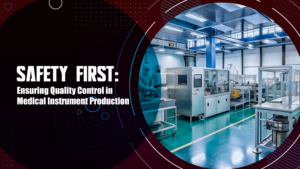Quality control is the prime aspect of medical instrument production, ensuring that every instrument meets rigorous standards of safety, reliability, and efficacy. From surgical tools to diagnostic devices, the meticulous process of quality control plays a critical role in safeguarding patient outcomes and maintaining trust in healthcare settings. Join us as we explore the essential components of quality control in medical instrument production and its pivotal importance in modern healthcare.
In the field of healthcare, precision and reliability are non-negotiable. Medical instruments are designed to perform with utmost accuracy and consistency to support healthcare professionals in delivering optimal patient care. Quality control encompasses a comprehensive set of processes and protocols that monitor every stage of instrument production, from raw material selection to final packaging. By adhering to strict quality standards, manufacturers ensure that each instrument meets or exceeds regulatory requirements and industry expectations.
Quality control begins at the earliest stages of instrument development. Engineers and designers collaborate to create detailed design specifications that align with clinical requirements and technological feasibility. During this phase, simulations and prototypes are tested to validate functionality, ergonomics, and compatibility with existing medical procedures. Any necessary adjustments are made to optimise performance and ensure the instrument’s effectiveness in real-world healthcare environments.
Selecting appropriate materials is crucial in ensuring the safety and durability of medical instruments. Manufacturers meticulously evaluate materials for biocompatibility, strength, corrosion resistance, and sterilisation compatibility. Raw materials such as stainless steel, titanium alloys, and medical-grade plastics undergo rigorous testing to verify mechanical properties, chemical composition, and performance under stress. This stringent evaluation ensures that materials meet regulatory standards and contribute to the instrument’s overall reliability and longevity.
Precision manufacturing processes are fundamental to achieving consistent quality in medical instrument production. Advanced technologies such as CNC machining, laser cutting, and additive manufacturing (3D printing) are employed to create components with micron-level accuracy. CNC machines use computer-controlled tools to carve intricate designs from raw materials, while laser cutting ensures precise edges and shapes. Additive manufacturing allows for the creation of complex geometries and customised components that enhance instrument performance and functionality.
Assembly of medical instruments involves meticulous attention to detail to ensure proper fit, alignment, and functionality of components. Each instrument undergoes comprehensive functional testing to verify performance according to design specifications. Functional tests may include mechanical stress tests, pressure testing, electrical safety checks (for electronic instruments), and calibration procedures. These tests ensure that instruments operate reliably and safely in diverse clinical settings, minimising the risk of malfunctions or performance inconsistencies during medical procedures.
Sterilisation validation is a critical aspect of quality control in medical instrument production, ensuring that instruments are free from harmful microorganisms before use. Manufacturers validate sterilisation processes through rigorous testing and monitoring to confirm their effectiveness in achieving sterility. Validation studies assess parameters such as temperature, pressure, exposure time, and sterilant concentration to ensure consistent and reliable sterilisation outcomes. This process is essential to prevent infections and ensure patient safety during surgical procedures and medical interventions.
Compliance with regulatory standards is paramount in medical instrument production. Manufacturers must adhere to stringent regulations and guidelines established by health authorities such as the FDA (Food and Drug Administration) in the United States or the CE marking requirements in Europe. Regulatory compliance ensures that instruments meet specific safety, performance, and quality standards before they can be marketed and used in healthcare settings. Regular audits, inspections, and documentation processes verify ongoing adherence to regulatory requirements, reinforcing confidence in the safety and reliability of medical instruments.
Quality control in medical instrument production is a dynamic process that embraces continuous improvement and customer feedback. Manufacturers actively solicit input from healthcare professionals to identify areas for enhancement and innovation. Research and development initiatives focus on integrating new technologies, improving materials, and optimising manufacturing processes to address emerging healthcare challenges. By fostering a culture of innovation and responsiveness, manufacturers drive advancements that enhance patient care, improve clinical outcomes, and advance the field of medical instrumentation.
Quality control in medical instrument production is an essential safeguard that ensures instruments meet the highest standards of safety, reliability, and performance. Through meticulous design verification, material testing, precision manufacturing, functional testing, sterilisation validation, and regulatory compliance, manufacturers uphold the integrity of healthcare delivery. By prioritising quality control, manufacturers contribute to improved patient outcomes, enhanced healthcare efficiency, and the advancement of medical innovation.
visit our website now now to know more.

